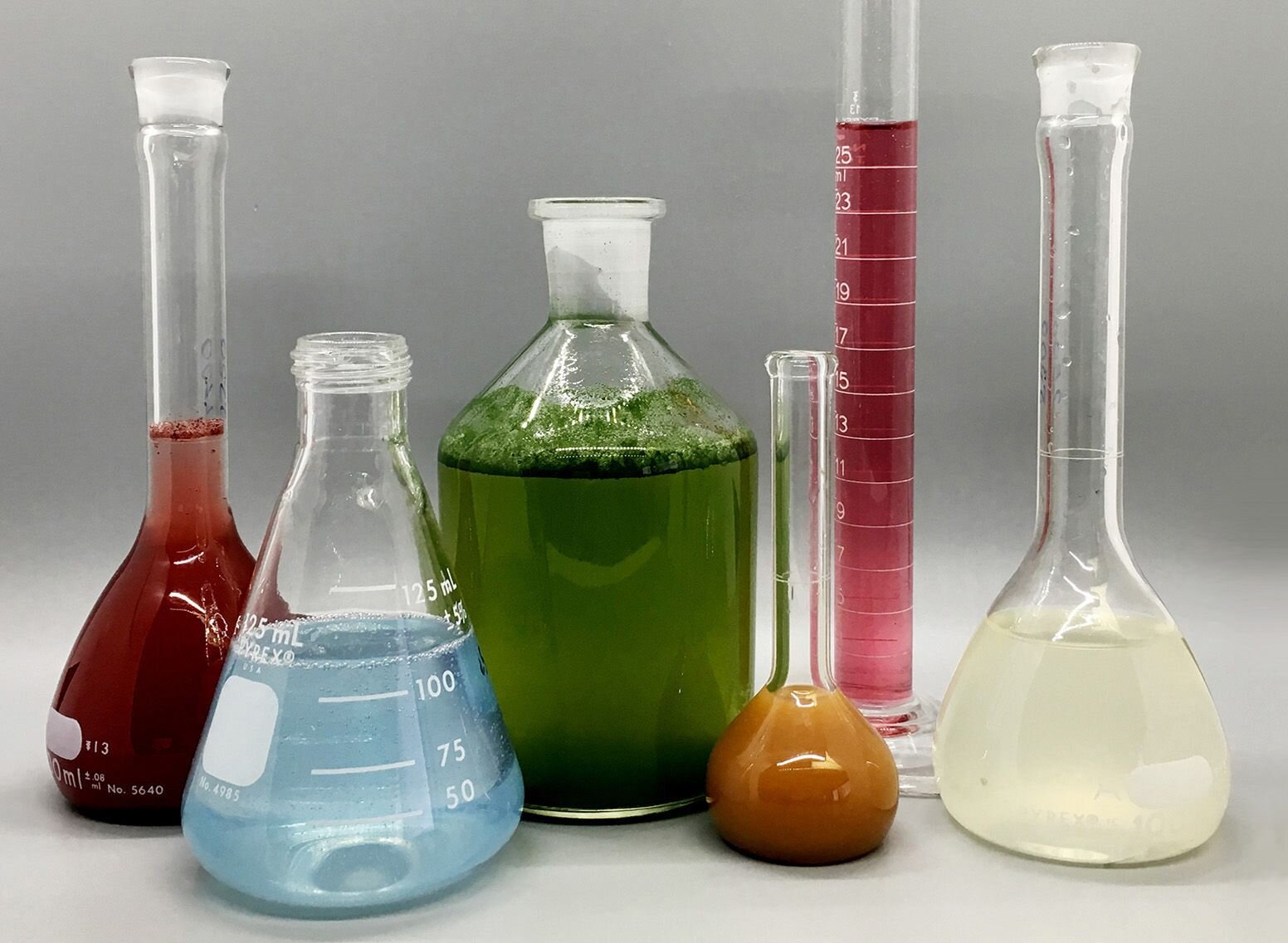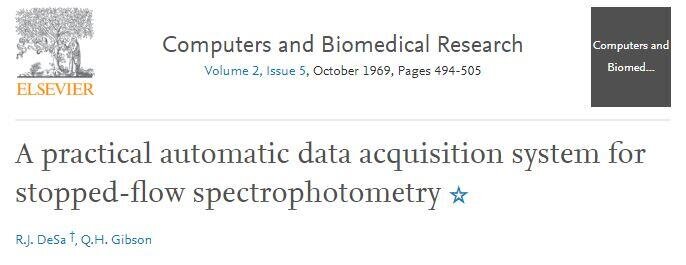Getting The Spectrophotometers To Work
Getting The Spectrophotometers To Work
Blog Article
Get This Report about Uv/vis/nir
Table of ContentsThe 4-Minute Rule for SpectrophotometersThe Definitive Guide for Circular DichroismThe Only Guide to Uv/visThe Of Circular Dichroism5 Simple Techniques For Uv/visThe Buzz on Circularly Polarized LuminescenceThe Only Guide to Uv/visExamine This Report about Circularly Polarized LuminescenceNot known Details About Uv/vis Our Spectrophotometers Statements4 Easy Facts About Circular Dichroism DescribedWhat Does Uv/vis/nir Do?The Ultimate Guide To Circularly Polarized Luminescence
It is then scanned through the sample and the reference solutions. Portions of the incident wavelengths are transmitted through, or shown from, the sample and the reference. The resultant light strikes the photodetector gadget, which compares the relative intensity of the 2 beams. Electronic circuits transform the relative currents into linear transmission portions and/or absorbance/concentration values.The transmission of a referral substance is set as a standard (datum) worth, so the transmission of all other compounds are tape-recorded relative to the preliminary "zeroed" substance. The spectrophotometer then transforms the transmission ratio into 'absorbency', the concentration of specific components of the test sample relative to the preliminary substance.
Because samples in these applications are not readily offered in large amounts, they are particularly matched to being evaluated in this non-destructive technique. In addition, precious sample can be conserved by making use of a micro-volume platform where as little as 1u, L of sample is required for complete analyses. A quick explanation of the treatment of spectrophotometry includes comparing the absorbency of a blank sample that does not consist of a colored substance to a sample which contains a colored compound.
Some Known Details About Circularly Polarized Luminescence
In biochemical experiments, a chemical and/or physical property is chosen and the treatment that is used is specific to that home in order to derive more info about the sample, such as the quantity, purity, enzyme activity, etc. Spectrophotometry can be utilized for a number of techniques such as identifying optimal wavelength absorbance of samples, figuring out ideal p, H for absorbance of samples, determining concentrations of unidentified samples, and figuring out the p, Ka of numerous samples.: 21119 Spectrophotometry is likewise a valuable process for protein filtration and can likewise be used as a method to develop optical assays of a substance.
It is possible to understand the concentrations of a 2 element mix utilizing the absorption spectra of the basic solutions of each element. To do this, it is needed to understand the termination coefficient of this mix at 2 wave lengths and the extinction coefficients of solutions that contain the recognized weights of the two components.

The Ultimate Guide To Spectrophotometers
Region. The concentration of a protein can be estimated by determining the OD at 280 nm due to the presence of tryptophan, tyrosine and phenylalanine.
Nucleic acid contamination can also interfere. This approach needs a spectrophotometer capable of determining in the UV area with quartz cuvettes.: 135 Ultraviolet-visible (UV-vis) spectroscopy involves energy levels that delight electronic transitions. Absorption of UV-vis light delights molecules that are in ground-states to their excited-states. Visible region 400700 nm spectrophotometry is utilized extensively in colorimetry science.
These curves can be used to check a new batch of colorant to examine if it makes a match to specifications, e
Traditional visible standard spectrophotometers can not detect if identify colorant or the base material has product. This can make it tough to handle color concerns if for example one or more of the printing inks is fluorescent. There are 2 significant setups for visual spectrum spectrophotometers, d/8 (spherical) and 0/45.
Researchers utilize this instrument to measure the quantity of substances in a sample. In the case of printing measurements two alternative settings are commonly utilized- without/with uv filter to manage much better the effect of uv brighteners within the paper stock.
All About Circularly Polarized Luminescence
Some applications require little volume measurements which can be carried out with micro-volume platforms. As described in the applications area, spectrophotometry can be used in both qualitative and quantitative analysis of DNA, RNA, and proteins. Qualitative analysis can be utilized and spectrophotometers are used to tape-record spectra of compounds by scanning broad wavelength areas to identify the absorbance properties (the intensity of the color) of the compound at each wavelength.

Circular Dichroism Can Be Fun For Everyone
One major aspect is the kind of photosensors that are readily available for different spectral areas, however infrared measurement is likewise tough due to the fact that practically everything produces IR as thermal radiation, specifically at wavelengths beyond about 5 m. Another problem is that rather a couple of products such as glass and plastic soak up infrared, making it incompatible as an optical medium.
Samples for IR spectrophotometry might be smeared between 2 discs of potassium bromide or ground with potassium bromide and pushed into a pellet. Where liquid options are to be measured, insoluble silver chloride is used to build the cell. Spectroradiometers, which operate almost like the noticeable region spectrophotometers, are designed to determine try this the spectral density of illuminants. Obtained Dec 23, 2018. Basic Lab Methods for Biochemistry and Biotechnology (2nd ed.). The vital guide to analytical chemistry.
Chichester, NY: Wiley. pp. 1617. ISBN 9780471974123. OCLC 36543293. Ninfa AJ, Ballou DP (2004 ). Essential lab methods for biochemistry and biotechnology. Hoboken: Wiley. p. 66. ISBN 9781891786006. OCLC 633862582. Rendina G (1976 ). Philadelphia, PA: W. B. Saunders Business. pp. 46-55. ISBN 0721675506. OCLC 147990. Oke, J. B.; Gunn, J. E.
Uv/vis/nir Fundamentals Explained
"Secondary standard stars for absolute spectrophotometry". The Astrophysical Journal. 266: 713. Bibcode:1983 Ap, J..266..713 O. doi:10. 1086/160817. Ishani, G (2006 ). "The very first commercial UV-vis spectrophotometer". p. 100. Obtained Dec 23, 2018. Simoni, RD; Hill, RL; Vaughan, M; Tabor, H (Dec 5, 2003). "A Classic Instrument: The Beckman DU Spectrophotometer and Its Innovator, Arnold O.
278 (49 ): e1. doi:. ISSN 1083-351X. Beckman, A. O.; Gallaway, W. S.; Kaye, W.; Ulrich, W. F. (March 1977). "History of spectrophotometry at Beckman Instruments, Inc". Analytical Chemistry. 49 (3 ): 280A300A. doi:10. 1021/ac50011a001. "Hewlett Packard: Compound Recognition with HP 8450 A UV Visible Spectrophotometer". Analytical Chemistry. 51 (12 ): 1188A1189A. 1979-10-01.
Ninfa AJ, Ballou DP, Benore M (2015 ). Fundamental Laboratory Methods for Biochemistry and Biotechnology (3, rev. ed.). spectrophotometers. Lab Equipment.
A Biased View of Uv/vis
"Applied Spectrophotometry: Analysis of a Biochemical Mixture". Biochemistry and Molecular Biology Education. Journal of Biochemistry Education.
Examine This Report on Spectrophotometers
U.S. Department of Commerce National Bureau of Standards unique publication; 378. Washington, D.C.: U.S. National Bureau of Standards. p. 2. OCLC 920079.
The procedure begins with a regulated light source that illuminates the examined sample. When it comes to reflection, as this light interacts with the sample, some is soaked up or emitted. The given off light travels to the detector, which is analyzed, measured, and presented as industry-standard color scales and indices.
All terms are evaluated over the noticeable spectrum from 400 to 700 nm. In the case of transmission, when the light communicates with the sample, it is either taken in, shown, or transferred.
See This Report about Circular Dichroism
Examples include APHA (American Public Health Association) for watercolor and purity analysis, ASTM D1500 for petrochemical color analysis, edible oil indices used in food, and color analyses of beverages. All terms are examined over the noticeable spectrum from 400 to 700 nm.
Image Credit: Matej Kastelic/ Dr. Arnold J. Beckman and his coworkers at the National Technologies Laboratories initially developed the spectrophotometer in 1940. In 1935 Beckman founded the business, and the discovery of the spectrophotometer was their most ground-breaking development. Dr. Bruce Merrifield, a Nobel prize-winning biochemist, specified that the creation of the spectrophotometer was "most likely the most essential instrument ever developed towards the improvement of bioscience." Before the discovery of the spectrophotometer, chemical analyses took weeks to complete, with 25% accuracy.
The 2-Minute Rule for Spectrophotometers
Over time, researchers kept enhancing the spectrophotometer design to boost its performance. The UV abilities of the design B spectrophotometer were enhanced by changing the glass prism with a quartz prism.
After 1984, double-beam variations of the device were designed. The addition of external software with the arrangement of onscreen display screens of the spectra can be found in the 1990s. Typically, a spectrophotometer is made up of 2 instruments, namely, a spectrometer and a photometer. A basic spectrophotometer consists of a source of light, a monochromator, a collimator for straight beam transmission, a cuvette to put a sample, and a photoelectric detector.
A Biased View of Circular Dichroism
There are different types of spectrophotometers in various shapes and sizes, each with its own purpose or performance. A spectrophotometer figures out how much light is reflected by chemical elements. spectrophotometers. It measures the distinction in light strength based upon the overall amount of light presented to a sample and the quantity of light beam that goes through the sample option
A spectrophotometer is utilized to determine the concentration of both colorless and colored solutes in an option. This instrument is used to figure out the rate of a reaction.
Report this page